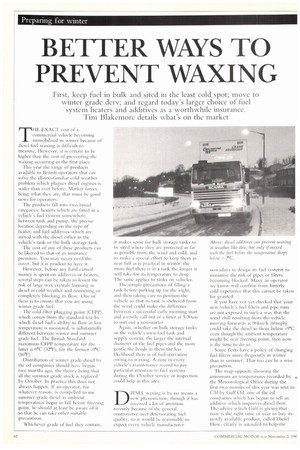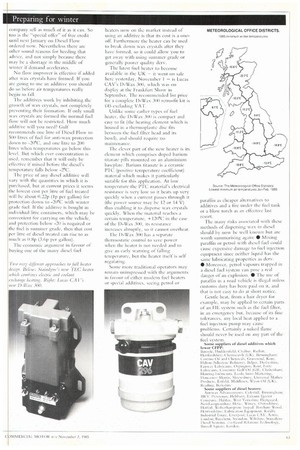BETTER WAYS TO PREVENT WAXING
Page 64

Page 65

If you've noticed an error in this article please click here to report it so we can fix it.
First, keep fuel in bulk and sited in the least cold spot; move to winter grade derv; and regard today's larger choice of fuel system heaters and additives as a worthwhile insurance. Tim Blakemore details what's on the market THE EXACT cost of a commercial vehicle becoming immobilised in winter because of diesel fuel waxing is difficult to
measure. However, it is certain to be higher than the cost of preventing the waxing occurring in the first place.
This year the range of products available to British operators that can solve the all-too-familiar cold weather problem which plagues diesel engines is wider than ever before. Market forces being what they are, that must be good news for operators.
The products fall into two broad categories: heaters which are fitted in a vehicle's fuel system somewhere between tank and pump, the precise location depending on the type of heater, and fuel additives which are mixed with the diesel either in the vehicle's tank or the bulk storage tank.
The cost of any of these products can be likened to that of an insurance premium. You may never need the cover, but it is prudent to have it_ However, before any hard earned money is spent on additives or heaters, several steps can be taken to lessen the risk of large wax crystals forming in diesel in cold weather and restricting or completely blocking its flow. One of these is to ensure that you are using winter grade fuel.
The cold filter plugging point (CFPP), which comes from the standard test by which diesel fuel's Ability to flow at low temperature is measured, is substantially different between winter and summer grade Mel. The British Standard maximum CFPP temperature for the latter is 0°C (32°F), Mr the former -9°C (16°F).
Distribution of winter grade diesel by the oil companies should have begun two months ago, the theory being that all the summer grade stock is replaced by October. In practice this does not always happen. If an operator, for whatever reason, is compelled to use summer grade diesel is ambient temperatures begin to fall below freezing point, he should at least be aware of it so that he can take other suitable precautions.
Whichever grade of fuel they contain, it makes sense for hulk storage tanks to be sited where they are protected as far as possible from the wind and cold, and to make a special effort to keep them as near full as is practical in winter: the more fuel there is in a tank the longer it will take for its temperature to drop. The same applies to Links on vehicles.
The simple precautions of tilling a tank before parking up for the night, and then taking care to position the vehicle so that its tank is sheltered from the wind could make the difference between a successful early morning start and a costly call out of a titter at 5.30ain to sort out a null-starter Again, whether on bulk storage tanks or the vehicle's own fuel tank and supply system, the larger the internal diameter of the fuel pipes and the more gentle the bends in them the less likelihood there is of fuel starvation owing to waxing. A note in every vehicle's maintenance record to pay particular attention to fuel systems during the October service or inspection could help in this area.
DIESEL waxing is by no means a new phenomenon, though it has received a lot of attention recently because of the general controversy over deteriorating fuel quality, so it would be reasonable to expect every vehicle manufacturer
nowadays to design its fuel systems to minimise the risk of pipes or filters becoming blocked, Many an operator we know will confirm from bitterly cold experience that this cannot be taken for granted.
you have not yet checked that your new vehicle's fuel filters and pipe runs are not exposed in such a way that the wind chill resulting from the vehicle moving forwards at 96koilh Mrriph) could take the diesel in them below -9°C even though the ambient temperature might be near freezing point, then now is the time to do so.
Some fleets have a policy of changing fuel filters more frequently in winter than in summer. That too can be a wise precaution.
The map opposite showing the minimum air temperatures recorded by , the Meteorological Office during the first two months of this year was sent to CM by Gulf Oil, one of the oil
companies which has begun to sell an additive which improves diesel flow. The advice which Gulf is giving that now is the right time of year to buy its. newly available product, called Diesel Flow, clearly is intended to help the
company sell as much of it as it can. So too is the "special offer" of free credit until next January on Diesel Flow ordered now. Nevertheless there are other sound reasons for heeding that advice, and not simply because there max' be a shortage in the middle of winter if demand accelerates.
No flow improver is effective if added alter wax crystals have formed. If you are going to use an additive you should do so before air temperatures really begin to fall.
The additives work by inhibiting the growth. or wax crystals, not completely preventing their formation. lf only small wax crystals arc formed the normal fuel flow will not be restricted. How much additive will you need? Gulf rec mtmends one litre of Diesel Flow to. 50(1 litres of fuel for anti-wax protection down to -20°C. and one litre to 200 litres when temperatures go below this ley J. But which ever concentration is used, remember that it will only be effictive if mixed before the diesel's ten 'poi-attire falls below -2°C.
The price of any diesel additive will vary with the quantities in which it is purchased, but at current prices it seems the lowest cost per litre of fuel treated will be about 0.22p (lp per gallon) for protection down to -20°C with winter grade Mel_ Itthe additive is bought in individual litre containers, which may be convenient for carrying on the vehicle. And pretection below -20 is required or the fuel is summer grade, then that cost per litre of diesel treated can rise to as much as 0.8p (3.6p per gallon).
The economic argument in favour of buying one of the many diesel fuel heaters now on the market instead of using au additive is that its cost is a oneoff. Furthermore the heater can be used to break down wax crystals after they have formed, so it could allow you to get away with using summer grade or generally poorer quality derv.
The latest fuel heater to become available in the UK — it went on sale here yesterday, November I — is Lucas CAV's 1)-Wax 300, which was on display at the Frankfurt Show in September. The recommended list price for a complete 1)-Wax 300 retro-fit kit is :4:~3 excluding VAT.
Unlike sonic earlier types Of fuel heater, the 1)-Wax 3(10 is compact and easy to fit (the hearing element which is housed in a thermoplastic disc tits between the fuel filter head and its bowl), and should require no maintenance.
The clever parr of the new heater is its clement which comprises doped barium titanate pills mounted on an aluminium baseplate. Barium titallate i5 a ceramic PT C. (positive temperature coefficient) material which makes it particularly suitable for this application. At low temperature the PIG material's electrical resistance is very low so it hears up very quickly when a current passes through it (the power source may be 12 or 14 V) thus enabling it to disperse wax crystals quickly. When the material reaches a certain temperature, +1211°C in the case of the 1)-Wax 300, its resistance
increases abruptly, so it cannot overheat.
The 1)-Wax 301; has .1 separate therniostatic cmitrol to save power when the hearer is not needed and to give an early warning of filling temperature, but the heater itself is self regulating,
Some more traditional operators may remain unimpressed with the arguments in favour of either modern fuel heaters or special additives, seeing petrol or paraffin as cheaper alternatives to additives and a fire under the fuel tank or a blow torch as an effective last resort.
The many risks associated with these methods of dispersing wax in diesel should by now be well known but are worth summarising again: • Mixing paraffin or petrol with diesel fuel could cause expensive damage to fuel injection equipment since neither liquid has the same lubricating properties as derv.
• Moreover, petrol vapours trapped in a diesel fuel System can pose a-real danger of an explosion. • The use of paraffin in a road vehicle is illegal unless customs duty has been paid on it, and that is not easy to do at short notice.
Gentle heat, from a hair dryer for example, may be applied to certain parts of an FIE system such as the aid filter, in an emergency hut, because of its fine tolerances, any local heat applied to a fuel injection punt}, may cause problems. Certainly a naked flame should never be used in: any part of the fuel system.












































































































